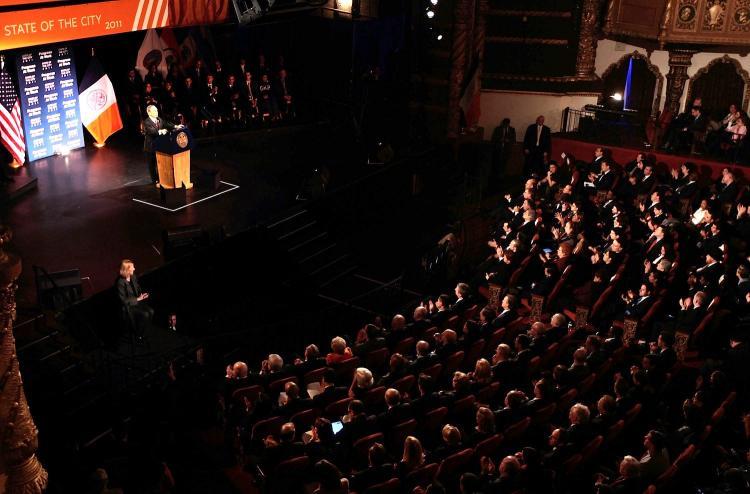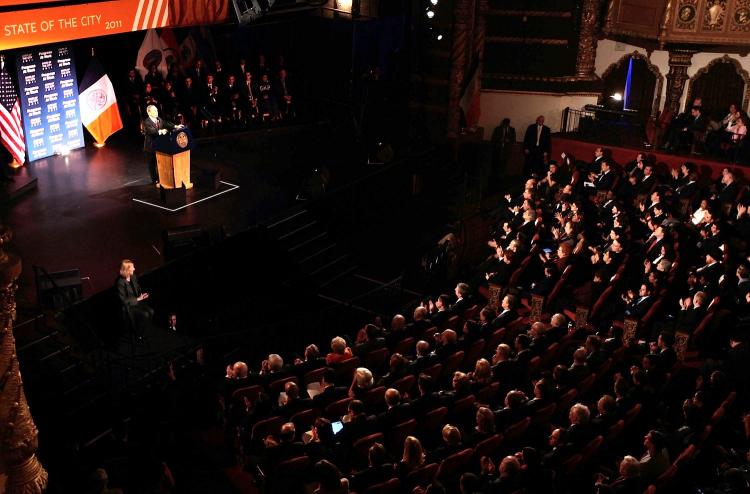NEW YORK—Mayor Michael Bloomberg gave his annual State of the City address on Wednesday afternoon in St. George’s Theater on Staten Island. The old theater, which lay in disuse and disrepair for many years but has since been successfully recovered and is now thriving, provided a suitable venue for his address, noted the mayor.
Bloomberg laid out his plans for the city’s recovery from the wrecking ball of budget cuts.
“There is no rabbit left to pull out of a hat. There is no windfall coming from Albany or the stimulus this year. There is only us,” he said.
The budget is certainly tight, but the mayor didn’t mention the deficit once, choosing to focus on solutions rather than problems.
Bloomberg stated that he would not raise taxes. He plans to continue working on the unemployment problem, fostering young entrepreneurs, revitalizing the waterfront, cutting pensions and benefits of non-uniform city employees, and making the government more efficient.
Jobs are key, the mayor noted, adding that the city has already made some progress on this front with 51,000 private sector jobs created last year at an income level of $32,000 to $95,000 a year.
The commercial vacancy rate and the unemployment rate have both dropped over the past year, he reported. The city plans to open 10 new Work Force One employment centers this year.
With 48 million tourists visiting the city in 2010, New York was the number one tourist destination in the country for the second year in a row. Tourism industry jobs have remained plentiful, according to Bloomberg.
New York was also named the number one destination for young entrepreneurs in 2010. The “feeling of energy and optimism,” along with a sense that everything happens here first, brings the young up-and-comers to the city, the mayor noted. Several entrepreneurs joined him on stage during the address, including the developer of Foursquare, the hit social networking mobile application that was created five years ago around a kitchen table in the East Village.
“All of them are succeeding, and most importantly, they are all hiring,” said the mayor.
Bloomberg hopes to establish more incubators for young entrepreneurs, as well as for immigrants hoping to set up shop. The mayor took a hard line on immigration. He called the nation’s current immigration policy “ruinous,” saying that many immigrants with potential to contribute to the growth of the economy are fettered.
“We are a nation made of immigrants!” Bloomberg asserted. He said the city would work with congressional representatives to pressure Washington for change.
The mayor also proposed cutting out a lot of administrative clutter and doing away with many regulations that hinder New Yorkers in their daily lives with a program called Simplicity. The initiative will streamline the approval process to make it easier for businesses to get up and running, said the mayor, while a new category of livery cars will make it possible for New Yorkers from all boroughs, not just Manhattan, to hail a cab and be picked up on the side of the street.
An online forum will encourage citizen feedback and suggestions about how the city can make people’s lives easier. The administration may have opened a can of worms with this effort, but Bloomberg said they are following a model that has made companies such as Facebook a lot of money.
Facebook assesses the needs of its customers by “crowd sourcing”—encouraging online feedback. Where private companies organize around customer needs, Bloomberg said the city will organize around the needs of its residents.
“At the heart of Simplicity is the belief that the government should make it easier to live and work in New York City,” declared the mayor.
Bloomberg also asserted that New York City must have more autonomy from the state in order to be able to manage its own affairs efficiently. A financial reform bill will be a number one priority in Albany over the next few weeks, part of the bill will address liberating the city workers’ pension from state control.
“We pay the bills, let us get better prices,” Bloomberg stated.
Non-uniform city workers currently have a much more lucrative pension than most employees in the private sector. They are also able to retire at a younger age. The mayor wants to raise the retirement age for these employees to 60. He says the city will save $8 million in administration costs by consolidating the pension system. He plans to save an additional $200 million a year by cutting the $12,000 holiday bonuses paid to the non-uniform workers every year.
The mayor said he will keep in mind the lessons learned in the 1970s while making cuts, however. The fiscal crisis that resulted in a $10 billion city budget cut in 1975 actually cost the city an estimated $50 billion in the long-run, as neglect led to more long-term problems, according to an article on the American Public Health Association website.
“When you stop investing in the future, the future hits the road,” said the mayor. He said that he will continue with development projects throughout the city, even if they must be scaled back or if more private funding must be sought.
Bloomberg laid out his plans for the city’s recovery from the wrecking ball of budget cuts.
“There is no rabbit left to pull out of a hat. There is no windfall coming from Albany or the stimulus this year. There is only us,” he said.
The budget is certainly tight, but the mayor didn’t mention the deficit once, choosing to focus on solutions rather than problems.
Bloomberg stated that he would not raise taxes. He plans to continue working on the unemployment problem, fostering young entrepreneurs, revitalizing the waterfront, cutting pensions and benefits of non-uniform city employees, and making the government more efficient.
Jobs are key, the mayor noted, adding that the city has already made some progress on this front with 51,000 private sector jobs created last year at an income level of $32,000 to $95,000 a year.
The commercial vacancy rate and the unemployment rate have both dropped over the past year, he reported. The city plans to open 10 new Work Force One employment centers this year.
With 48 million tourists visiting the city in 2010, New York was the number one tourist destination in the country for the second year in a row. Tourism industry jobs have remained plentiful, according to Bloomberg.
New York was also named the number one destination for young entrepreneurs in 2010. The “feeling of energy and optimism,” along with a sense that everything happens here first, brings the young up-and-comers to the city, the mayor noted. Several entrepreneurs joined him on stage during the address, including the developer of Foursquare, the hit social networking mobile application that was created five years ago around a kitchen table in the East Village.
“All of them are succeeding, and most importantly, they are all hiring,” said the mayor.
Bloomberg hopes to establish more incubators for young entrepreneurs, as well as for immigrants hoping to set up shop. The mayor took a hard line on immigration. He called the nation’s current immigration policy “ruinous,” saying that many immigrants with potential to contribute to the growth of the economy are fettered.
“We are a nation made of immigrants!” Bloomberg asserted. He said the city would work with congressional representatives to pressure Washington for change.
The mayor also proposed cutting out a lot of administrative clutter and doing away with many regulations that hinder New Yorkers in their daily lives with a program called Simplicity. The initiative will streamline the approval process to make it easier for businesses to get up and running, said the mayor, while a new category of livery cars will make it possible for New Yorkers from all boroughs, not just Manhattan, to hail a cab and be picked up on the side of the street.
An online forum will encourage citizen feedback and suggestions about how the city can make people’s lives easier. The administration may have opened a can of worms with this effort, but Bloomberg said they are following a model that has made companies such as Facebook a lot of money.
Facebook assesses the needs of its customers by “crowd sourcing”—encouraging online feedback. Where private companies organize around customer needs, Bloomberg said the city will organize around the needs of its residents.
“At the heart of Simplicity is the belief that the government should make it easier to live and work in New York City,” declared the mayor.
Bloomberg also asserted that New York City must have more autonomy from the state in order to be able to manage its own affairs efficiently. A financial reform bill will be a number one priority in Albany over the next few weeks, part of the bill will address liberating the city workers’ pension from state control.
“We pay the bills, let us get better prices,” Bloomberg stated.
Non-uniform city workers currently have a much more lucrative pension than most employees in the private sector. They are also able to retire at a younger age. The mayor wants to raise the retirement age for these employees to 60. He says the city will save $8 million in administration costs by consolidating the pension system. He plans to save an additional $200 million a year by cutting the $12,000 holiday bonuses paid to the non-uniform workers every year.
The mayor said he will keep in mind the lessons learned in the 1970s while making cuts, however. The fiscal crisis that resulted in a $10 billion city budget cut in 1975 actually cost the city an estimated $50 billion in the long-run, as neglect led to more long-term problems, according to an article on the American Public Health Association website.
“When you stop investing in the future, the future hits the road,” said the mayor. He said that he will continue with development projects throughout the city, even if they must be scaled back or if more private funding must be sought.







